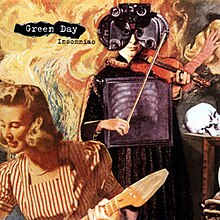
Green Day is an American rock band formed in the East Bay of California in 1987 by lead vocalist and guitarist Billie Joe Armstrong and bassist and backing vocalist Mike Dirnt, with drummer Tré Cool joining in 1990. In 1994, their major-label debut Dookie, released through Reprise Records, became a breakout success and eventually shipped over 10 million copies in the U.S. Alongside fellow California punk bands Bad Religion, the Offspring, Rancid, NOFX, Pennywise and Social Distortion, Green Day is credited with popularizing mainstream interest in punk rock in the U.S.
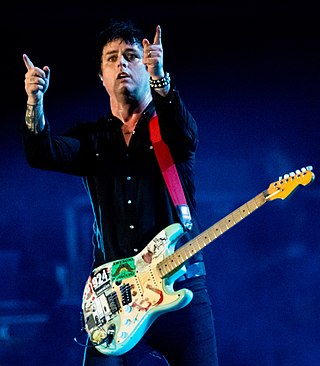
Billie Joe Armstrong is an American musician who is the lead vocalist, guitarist, and primary songwriter of the rock band Green Day, which he co-founded with Mike Dirnt in 1987. He is also a guitarist and vocalist for the punk rock band Pinhead Gunpowder, and provides lead vocals for Green Day's side projects Foxboro Hot Tubs, the Network, the Longshot and the Coverups. Armstrong has been considered by critics as one of the greatest punk rock guitarists of all time.
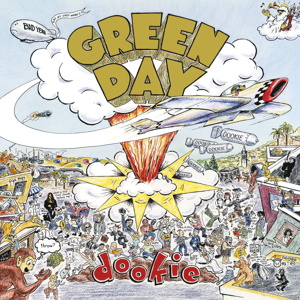
Dookie is the third studio album by the American rock band Green Day, released on February 1, 1994, by Reprise Records. The band's major label debut and first collaboration with producer Rob Cavallo, it was recorded in late summer 1993 at Fantasy Studios in Berkeley, California. Written mostly by frontman and guitarist Billie Joe Armstrong, the album is largely based on his personal experiences and includes themes such as boredom, anxiety, relationships, and sexuality. It was promoted with four singles: "Longview", "Basket Case", a re-recorded version of "Welcome to Paradise", and "When I Come Around".

...And Out Come the Wolves is the third studio album by American punk rock band Rancid. It was released on August 22, 1995, through Epitaph Records. Rancid's popularity and catchy songs made them the subject of a major label bidding war that ended with the band staying on Epitaph. With a sound heavily influenced by ska, which called to mind Tim Armstrong and Matt Freeman's past in Operation Ivy, Rancid became one of the few bands of the mid-to late-1990s boom in punk rock to retain much of its original fanbase. In terms of record sales and certifications, ...And Out Come the Wolves is a popular album in the United States. It produced three hit singles: "Roots Radicals", "Time Bomb" and "Ruby Soho", that earned Rancid its heaviest airplay on MTV and radio stations to date. All the singles charted on Modern Rock Tracks. ...And Out Come the Wolves was certified gold by the RIAA on January 22, 1996. It was certified platinum on September 23, 2004.

International Superhits! is the first greatest hits compilation by American rock band Green Day, released November 13, 2001, through Reprise Records. It collects all of the band's singles released between 1994 and 2000 as well as a rerecording of "Maria", a B-side from Waiting, and a previously unreleased track, "Poprocks & Coke". A DVD and VHS titled International Supervideos! was released simultaneously, collecting fifteen of the band's music videos spanning the same period. Both releases have been certified Platinum in the United States for sales of over 1 million copies and 3× Platinum in the United Kingdom for sales of 900,000.

Nimrod is the fifth studio album by the American rock band Green Day, released on October 14, 1997, by Reprise Records. The band began work on the album in the wake of the cancellation of a European tour after the release of their previous album, Insomniac. Recorded at Conway Recording Studios in Los Angeles, the album was written with the intent of creating a set of standalone songs as opposed to a cohesive album. Retrospectively, Nimrod is noted for its musical diversity and experimentation, containing elements of folk, hardcore, surf rock, and ska. Lyrical themes discussed include maturity, personal reflection, and fatherhood.
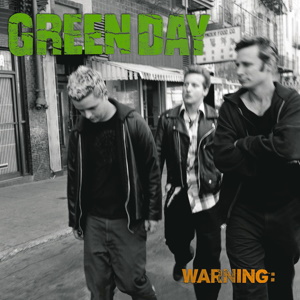
Warning is the sixth studio album by the American rock band Green Day, released on October 3, 2000, by Reprise Records. Building upon its predecessor Nimrod (1997), it eschewed the band's trademark punk rock sound and incorporated acoustic elements and pop and folk styles. Lyrically, the album contains more optimistic and inspirational themes in comparison to the band's earlier releases. Warning was also Green Day's first album since Kerplunk (1991) that was not produced by Rob Cavallo, although he did have a hand in its production and was credited as executive producer.

American Idiot is the seventh studio album by the American rock band Green Day, released on September 21, 2004, by Reprise Records. As with their previous four albums, it was produced by Rob Cavallo in collaboration with the group. Recording sessions for American Idiot took place at Studio 880 in Oakland and Ocean Way Recording in Hollywood, both in California, between 2003 and 2004. A concept album, dubbed a "punk rock opera" by the band members, American Idiot follows the story of Jesus of Suburbia, a lower-middle-class American adolescent anti-hero. The album expresses the disillusionment and dissent of a generation that came of age in a period shaped by tumultuous events such as 9/11 and the Iraq War. In order to accomplish this, the band used unconventional techniques for themselves, including transitions between connected songs and some long, chaptered, creative compositions presenting the album themes.

"Basket Case" is a song by rock band Green Day, released on August 1, 1994 by Reprise Records as the second single from the band's third studio album, Dookie (1994). The song spent five weeks at the top of the US Billboard Alternative Songs chart and garnered a Grammy Award nomination in the category for Best Rock Vocal Performance by a Duo or Group. Its music video was directed by Mark Kohr and filmed in an abandoned mental institution in California. In 2001, the song appeared on their greatest hits album International Superhits!. In 2021, "Basket Case" was ranked number 150 in Rolling Stone's updated list of the "500 Greatest Songs of All Time". As of March 2024, "Basket Case" is the most streamed song by the band on Spotify, with over 1 billion streams.
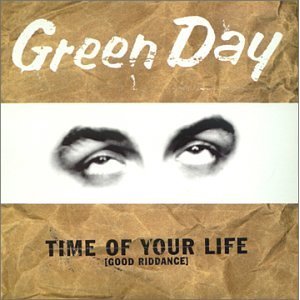
"Good Riddance (Time of Your Life)" (or "Time of Your Life (Good Riddance)") is a song by American rock band Green Day, released in December 1997 as the second single from their fifth studio album, Nimrod (1997). It is one of their most popular songs and has also become a staple of their concerts, usually played as the final song.

"Geek Stink Breath" is a song by American rock band Green Day. It was released on September 25, 1995, as the lead single and fourth track from their fourth studio album, Insomniac (1995). The song, along with "Stuck with Me", appeared on the live EP Foot in Mouth that was only released in Japan. The lyrics expound the effects of methamphetamine on the human body; the word "geek" is slang for methamphetamine.
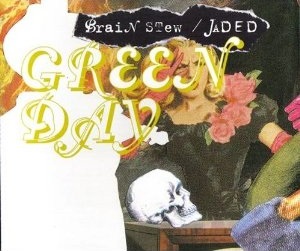
"Brain Stew" and "Jaded" are two songs released as a joint single by American rock band Green Day. They appear as the tenth and eleventh tracks and third and final single from the group's fourth studio album, Insomniac. The song was also included on Godzilla: The Album. The two songs were released as one single, as the songs are transitional – "Brain Stew" segues directly into "Jaded". After 9/11, "Brain Stew" was placed on Clear Channel's list of post-9/11 inappropriate titles. The song "Brain Stew" is about vocalist/guitarist Bille Joe Armstrong dealing with insomnia. According to Armstrong himself, "Brain Stew" was originally called "Insomniac" on demo, and "Brain Stew" is a reference to Armstrong's long-time friend, James Washburn, who is nicknamed Brain Stew.
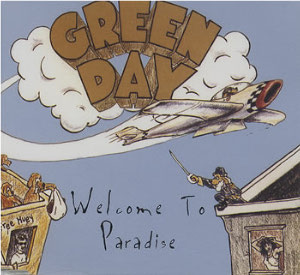
"Welcome to Paradise" is a song by the American rock band Green Day. It first appeared as the third track on the band's second studio album, Kerplunk (1991). It was re-recorded and rereleased as the fifth track on the band's third studio album, Dookie (1994), and released as the album's third single. Its physical release was exclusive to the United Kingdom on October 17, 1994, though the song still saw radio airplay in the United States. The song peaked at number 56 on the US Billboard Hot 100 Airplay chart. The Dookie version is more popular and was later included on the band's 2001 compilation album International Superhits!.

"She" is a song by the American rock band Green Day. It is the eighth track on their third album, Dookie and was released as Green Day's first promotional single in their discography. The song was written by frontman Billie Joe Armstrong about a former girlfriend who showed him a feminist poem with an identical title. In return, Armstrong wrote the lyrics of "She" and showed them to her. She later dumped him and moved to Ecuador, prompting Armstrong to put "She" on the album. The same ex-girlfriend is the topic of the songs "Sassafras Roots" and "Chump". It is one of the few Green Day singles that did not have a music video.

The American rock band Green Day has released 14 studio albums, four live albums, four compilation albums, one soundtrack album, four video albums, 12 extended plays, 4 box sets, 48 singles, 10 promotional singles, 3 anniversaries, and 56 music videos. The band has sold over 75 million records worldwide, including more than 24 million in certified album sales in the United States. Green Day released their first two studio albums, 1,039/Smoothed Out Slappy Hours (1991) and Kerplunk (1991), through the independent label Lookout! Records before signing to major label Reprise Records. Dookie, the band's first album on the label and third studio album overall, was released in February 1994. It was a breakout success, selling over 10 million copies in the United States and 20 million copies worldwide. Dookie spawned five singles, including the international hits "Longview", "Basket Case" and "When I Come Around". The album placed Green Day at the forefront of the 1990s punk rock revival.

The American Idiot World Tour was a concert tour by American rock band Green Day in support of the group's seventh studio album, American Idiot, which was released in September 2004. The tour began in Los Angeles at the Grand Olympic Auditorium on July 29, and the last show was in Australia at the Telstra Dome. During the tour, the band played at the 2004 Reading Festival in England.

¡Uno! is the ninth studio album by the American rock band Green Day, released on September 25, 2012, by Reprise Records. It is the first of three albums in the ¡Uno!, ¡Dos!, ¡Tré! trilogy, a series of studio albums released from September 2012 to December 2012. Green Day recorded the album from February to June 2012 at Jingletown Studios in Oakland, California. This is the band's first album recorded as a quartet, as touring guitarist Jason White joined the band in the studio to give the studio recordings a more live feel.
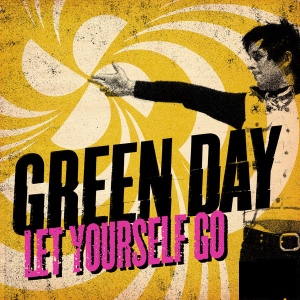
"Let Yourself Go" is a song by American rock band Green Day. The song is featured as the fourth track on their ninth studio album ¡Uno! (2012). Written by Billie Joe Armstrong and produced by Rob Cavallo, the song was released as the third and final single from the album on September 5, 2012. However, the "official live video" of the song was revealed on August 1, 2012. It is also the third single from the ¡Uno!, ¡Dos! & ¡Tré! trilogy.

Revolution Radio is the twelfth studio album by the American rock band Green Day, released on October 7, 2016 through Reprise Records. A self-produced effort, it marked their first release since 2009's 21st Century Breakdown not to be produced by longtime producer Rob Cavallo. It is also their first since said album to be recorded as a trio. Green Day's previous three albums ¡Uno!, ¡Dos!, and ¡Tré! featured touring guitarist Jason White temporarily joining the band in the studio. It is their first album since 2000's Warning to not carry a parental advisory label, although the track "Youngblood" features profanity.

Father of All Motherfuckers is the thirteenth studio album by the American rock band Green Day, released on February 7, 2020, through Reprise Records. Produced by Butch Walker, Chris Dugan, and the band, the album marks a complete departure from the band's traditional punk rock sound, incorporating garage rock elements similar to their tenth studio album, ¡Dos!.
